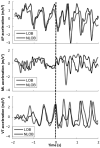Near-Fall Detection in Unexpected Slips during Over-Ground Locomotion with Body-Worn Sensors among Older Adults
- PMID: 35591025
- PMCID: PMC9102890
- DOI: 10.3390/s22093334
Near-Fall Detection in Unexpected Slips during Over-Ground Locomotion with Body-Worn Sensors among Older Adults
Abstract
Slip-induced falls are a growing health concern for older adults, and near-fall events are associated with an increased risk of falling. To detect older adults at a high risk of slip-related falls, this study aimed to develop models for near-fall event detection based on accelerometry data collected by body-fixed sensors. Thirty-four healthy older adults who experienced 24 laboratory-induced slips were included. The slip outcomes were first identified as loss of balance (LOB) and no LOB (NLOB), and then the kinematic measures were compared between these two outcomes. Next, all the slip trials were split into a training set (90%) and a test set (10%) at sample level. The training set was used to train both machine learning models (n = 2) and deep learning models (n = 2), and the test set was used to evaluate the performance of each model. Our results indicated that the deep learning models showed higher accuracy for both LOB (>64%) and NLOB (>90%) classifications than the machine learning models. Among all the models, the Inception model showed the highest classification accuracy (87.5%) and the largest area under the receiver operating characteristic curve (AUC), indicating that the model is an effective method for near-fall (LOB) detection. Our approach can be helpful in identifying individuals at the risk of slip-related falls before they experience an actual fall.
Keywords: balance loss; deep learning; gait-slip; machine learning; near-fall.
Conflict of interest statement
The authors declare no conflict of interest.
Figures



References
-
- Boyé N.D., Van Lieshout E.M., Van Beeck E.F., Hartholt K.A., Van der Cammen T.J., Patka P. The impact of falls in the elderly. Trauma. 2013;15:29–35. doi: 10.1177/1460408612463145. - DOI
MeSH terms
Grants and funding
LinkOut - more resources
Full Text Sources

